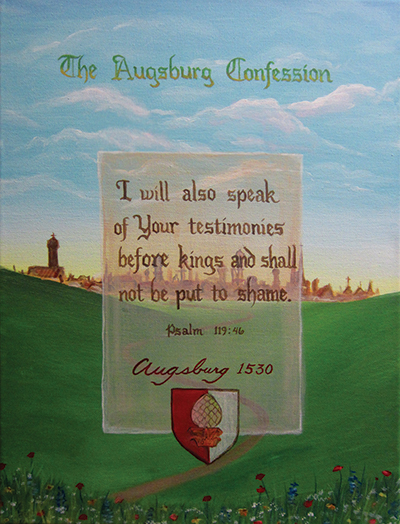Reformation 2017 Artwork: The Augsburg Confession
Editor’s Note: Kelly Klages has agreed to prepare six pieces of original art for Lutheran Church–Canada (LCC) commemorating the 500th anniversary of the Reformation in 2017. Each piece of art will be featured on the covers of this year’s issues of The Canadian Lutheran magazine.
In addition, each piece of art is being made available to LCC congregations as a free, downloadable poster. You can print out the posters, along with accompanying artist’s statement, as they become available at www.reformation2017.ca/resources/posters/.
by Kelly Klages
 As autumn reaches its pinnacle, Reformation celebrations and tributes are now moving into full gear. Church events are underway, potlucks and community events are humming along, pastors are dressing up as Martin Luther… (I speak from personal observation). Thanks to the spark that was the posting of the 95 Theses, October 31st has been recognized for some time as “Reformation Day.”
As autumn reaches its pinnacle, Reformation celebrations and tributes are now moving into full gear. Church events are underway, potlucks and community events are humming along, pastors are dressing up as Martin Luther… (I speak from personal observation). Thanks to the spark that was the posting of the 95 Theses, October 31st has been recognized for some time as “Reformation Day.”
The irony is that the Lutheran church doesn’t officially subscribe to the theses. There is a much more critical date in our history that better sums up who we are—indeed, when the Lutheran church really consolidated and presented itself as a church with a distinct confession of faith. And that date was June 25, 1530, when the Augsburg Confession was presented to Emperor Charles V by princes and representatives of the German people, to explain the teachings of the Lutheran Reformation. Philip Melanchthon, Luther’s close friend and colleague, drafted the 28 articles that remain the gold standard, the most concise definition of Lutheran teaching to this day.
The emperor had political motivation to hear the princes that day. He wanted the Holy Roman Empire to present a united front against the invading Turks. Division meant political and strategical weakness. When a reading was permitted at the Augsburg Diet, attempts were made to minimize the impact—a small space was selected, where few could hear. Nonetheless, the confession was read in German so loudly that those gathered outside could hear it clearly.
This painting, the fifth in the series, is the first to be set in the clear light of day, rather than with the sense of hiddenness or private action. It depicts a skyline of the city of Augsburg, based on an old woodcut. From the city, a winding road extends, representing the outward path that the newborn Lutheran church would take as the effects of the Reformation continued to bear fruit and flourish. As an identifier for the city of Augsburg, its coat of arms, which was regularized in the 16th century in the midst of the events of the Reformation, is included in the image.
Superimposed on the city is a quote from the Psalms: “I will speak of Thy testimonies before kings, and will not be put to shame.” This quote prefaces the Augsburg Confession and emphasizes the need for boldness and conviction when it comes to speaking in faith. For the faith is not a matter of mere opinion or preference, but God’s own Word and testimonies. It is a reminder for all of us of the importance of standing firm in Christ.
———————
Kelly Klages is a writer and artist living in Morden, Manitoba.





